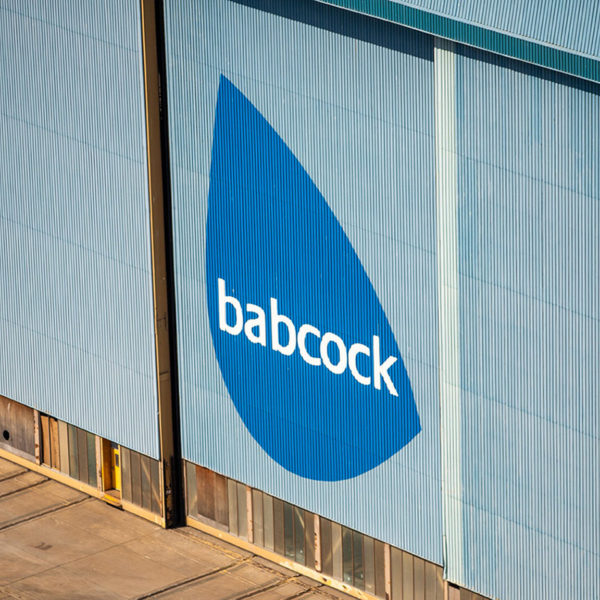8 Jan 2014
Babcock successfully completes first-of-class MSC installation

Installation and initial power-up of new Main Static Converters (MSCs) has been completed on HMS Vengeance during the current Long Overhaul Period and Refuel (LOP(R)) being undertaken by Babcock at Devonport Royal Dockyard, marking both a key milestone in the LOP(R) and a first-of-class implementation of Vanguard class life extension measures.
The MSCs replace the traditional 650kW Motor Generators (MGs); an essential part of the submarine’s onboard electrical power system. The MSCs provide a fixed, solid state power electronics alternative that avoids the need for rotating machinery, with huge advantages over MGs, being significantly more reliable and with considerably reduced through-life maintenance requirements. Replacing the MGs with the MSCs will improve submarine availability to perform the at-sea deterrence role. This first-of-class project, which follows some four years of development and planning, forms part of a programme that will ultimately see MSCs replacing MGs on all four Vanguard class submarines.
Installation of the two MSC suites began in January 2013 (following considerable planning by the HMS Vengeance LOP(R) team and MSC JPT to integrate the installation into the LOP(R) programme), and was completed in early September. On completion of the main battery installation the MSC suites were then powered up for the first time onboard last month (December 2013), marking the start of the MSC commissioning which will be done in stages. The next phase is to commission them when the ship’s diesel generators are operating, after which they will be operated and tested during Steam Machinery Trials, when they will work alongside the ship’s turbo generators. Final commissioning of the MSCs will take place in around 18 months time during final preparation for sea trials.
The MSC suites developed for the Vanguard class are a derivative of the system originally designed for the new Astute class submarines. Babcock and the MoD’s In-Service Submarines (ISM) team have been working together on this since January 2009, and the development programme has been taken forward by a joint project team involving the MoD, Babcock and Ultra PMES (the MSC Original Equipment Manufacturer and Equipment Design Authority), to enable integration of this new piece of equipment into an existing platform, while minimising time and cost consequences and optimising through life management.
As part of the development programme, electrical, constructive and mechanical integration requirements have been identified and addressed. Babcock undertook detailed assessments of the auxiliary machinery spaces on all Vanguard class submarines using a laser scanning technique which enabled a detailed 3D CAD model to be created for the mechanical and constructive designs. Among the challenges has been the need for the Vanguard class MSC solution to meet the higher power demands associated with ballistic nuclear submarines, while being smaller in size than the Astute class version in order to fit within the available compartment space.
Size and available space have been key issues from the point of view of both positioning and installation within the compartment and shipping routes into the submarine. Other considerations in finalising the equipment design have included electrical integration, and integration into the current control systems, as well as determining the best method to shock mount the new suites, and minimising changes to the existing cooling water system.
Installation involved removal and clearance of the original MGs and their seatings, welding in new seatings and structure to accept the MSCs and fitting of bed plates. The individual MSC units were lifted onboard and through the submarine to their final location with great care to avoid any damage to the sensitive units. A team of mechanical and electrical fitters, plus commissioning engineers, then connected the MSCs to the ship’s electrical systems and mechanical pipework cooling systems, and tested each system in turn. The installation phase has taken some 18,000 manhours, while commissioning will have involved around 10,000 manhours by the end of the LOP(R).
MoD PCM Vengeance, Cdr Ian Bartlett, commented: ‘The introduction of MSCs to the V Class through this successful project underlines the benefits of delivery through a partnering approach between MoD and our industrial partners. The 650kW Motor Generator sets replaced by the MSCs have a high maintenance requirement and have historically injected significant tension during submarine maintenance periods. Their removal improves the delivery of Continuous at Sea Deterrence.’
Babcock HMS Vengeance LOP(R) Project Manager Jon Benzie said: “We are delighted to have reached this important milestone with the installation and power up of the new MSCs successfully achieved. The close working between the Vengeance LOP(R) team and MSC joint project team has been vital to the successful integration of the MSC suites with minimised programme risk. Babcock’s ability to work with our customer from the concept phase of the project to final detailed designs and installation onboard has ensured that, from the outset, the people doing the job have been involved in the whole design cycle. This engendered an excellent team spirit with everyone fully committed to making this an absolute success.”